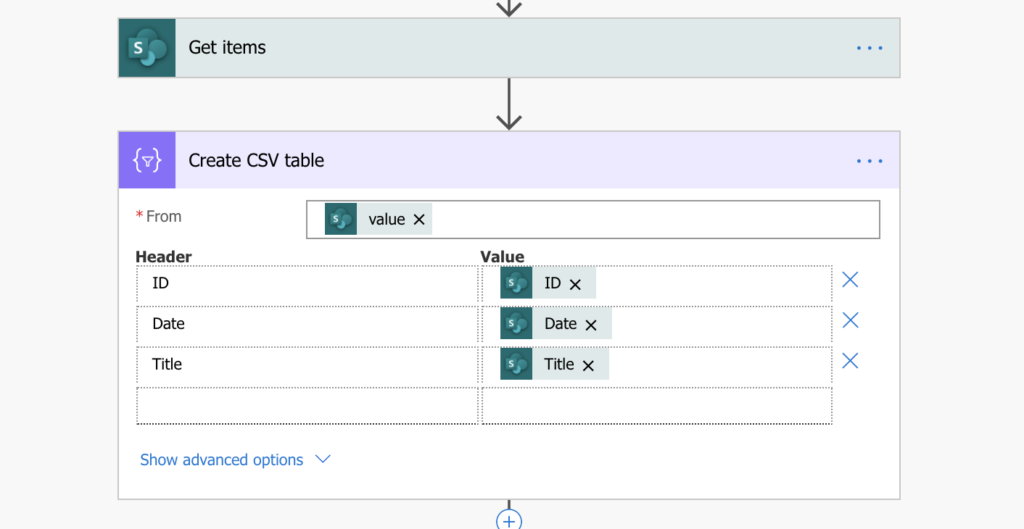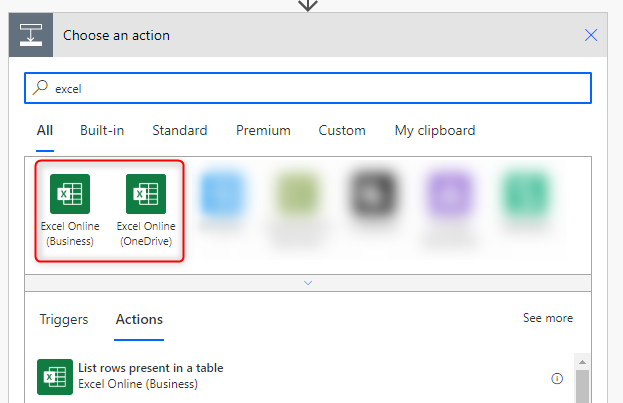- Power Automate Excel To Sharepoint List Example
- Sharepoint List To Excel Flow
- Power Automate Excel To Sharepoint Listening
- Power Automate Parse Excel File
- Workflow Automation with Microsoft Power Automate Aaron Guilmette Aaron Guilmette download Z-Library. Download books for free.
- Before proceeding with these instructions, make sure your SharePoint site is set up with the required lists and libraries. In your SharePoint site, browse to the Projects list. To create and manage flows for a list or a library, from the command bar, on the list or library page, select Automate Power Automate.
- Hello, When I set 'Top Count' to 5000, perfectly all 5000 records were loaded from excel to SharePoint list. When I enable Pagination to import more than 5000 its not working, I attempted to set.
Generate Excel XLSX files from a template and save to a SharePoint library automatically in Automate (Microsoft Flow), Azure Logic Apps, and PowerApps. Exclude certain lists, libraries, sites or links from SharePoint search results easily by configuring the search scope rules.
Note
Ad blocker free download mac. There is simpler way to create Excel and PDF documents from a template and use the result in Power Automate if needed.
If you want to automate the generation of purchase orders in your company, this article will help you achieve that.After going through it you will know how to create an XLSX file from a template using Create XLSX document from template action from Plumsail Documents connector in Power Automate (Microsoft Flow) and Azure Logic Apps.
Probably you have some third party system, where you create data for purchase orders.Then you get this data in Power Automate (Microsoft Flow), apply it to our purchase order template and generate a new document.
This is how the final document will look in our case:
Our template and result document have to be stored somewhere. Power Automate (Microsoft Flow) has a lot of connectors for different systems. Here are just a few of them:
SharePoint
Box
OneDrive
Google Drive
Dropbox
SFTP
File System
In this example, we will store our documents in SharePoint. Our flow will use JSON object as a source data for the template, but you can get data from other sources. For example query list items from SharePoint.
This is how the flow looks like:
Flow trigger¶
Free construction estimating software for mac. You can actually pick any trigger. For example, you can start Flow on file creation in a SharePoint document library. We are using “Manually trigger a flow” trigger here to simplify the Flow.
Get file content¶
This action gets file content of the specified file from a SharePoint document library. You can just specify SharePoint site URL and path to your file. We are using this action to get our template’s content.
You can use any other connector to get files from your system.
Create XLSX Document from Template¶
Power Automate Excel To Sharepoint List Example
Create XLSX document from template is the action from Plumsail Documents connector. This action is suitable for creating documents from a template.

There are two parameters:
Template file
Template data
In the first parameter ‘Template file’ you can put template’s content from some other action. In our case, we specified the output of the previous action as a template.
Download the template file that we will use in this article.

Plumsail Excel XLSX templates use a different approach than most other templating solutions. It uses a minimal amount of syntax to make your work done.
Read this article to get familiar with the templating engine.
In short, templating engine thinks that everything between these {{}} brackets is basically variables where it will write the data you specified in ‘Template data’.In our case, the example would be {{Order.Date}} and {{Order.Number}} object, it lets the engine know that we want to render the purchase order’s number and date.
But of course, we can implement a more complex scenario, in our template we are referring properties inside simple objects and collections, as well as properties in nested constructions.To select properties of our objects inside of the array (in JSON data) we are using a dot operator:
The
{{Vendor.CompanyName}},{{Vendor.Address}},{{Vendor.Email}},{{Vendor.Phone}}tags let the engine know that we want to render properties of the Vendor object.The
{{ShipTo.CompanyName}},{{ShipTo.Address}},{{ShipTo.Email}},{{ShipTo.Phone}}tags let the engine know that we want to render properties of the ShipTo object.The
{{items.product.name}},{{items.quantity}},{{items.product.price}},{{items.cost}}tags get the name, quantity, price and total cost properties in each item’s product object.
The templating engine is smart enough to understand that we refer properties inside a collection.That is how it knows what content we need to be duplicated. It will iterate through all objects in the array to render them and add the rows automatically.
You can learn more about table rendering here.
Please also note that we are using these formulas to calculate the total cost for each item individually and for all of the items:
=[Quantity]*[UnitPrice]- for each item=SUM(D14)- for all of the items
In the second parameter, we specified data that is being applied to the template in JSON format:
Create file¶

Now you need to store text file somewhere. In our example, we use ‘Create file’ action from SharePoint connector to store the XLSX document in SharePoint document library.
You can use any other connector to store documents into your system.
Conclusion¶
Now you should have an idea how to use Create XLSX document from template action from Plumsail Documents connector for Power Automate (Microsoft Flow).If you haven’t used it yet, registering an account would be the first step. It is quite easy to get started.
We will take a look at how to add/update excel data into your SharePoint List using Power Automate
Sharepoint List To Excel Flow
Note: To use Excel Online Connector of Power Automate, please make sure your that your excel data needs is in table layout
This is the glimpse of how your Flow will look like 😊
Let’s Start Creating it.
- Schedule/Automate your flow using schedule connector
- Use, List rows present in a table connector, add location of excel file details along with the table you want to move into your SharePoint List
Fig 1.1 Dinertown tycoon mac download.
- You will get your excel data in the form of an array, So, in the next step add apply to each condition wherein you will provide value of the list rows as an output from previous step as shown in the Fig 1.2
Fig 1.2
- Now, as we are creating a flow to update and add, we will look into the site list whether we have an item, if not create a new one
- So, use SharePoint Get items connector and then add this expression in your condition (This expression checks the length of an item in your list)
Expression: length(outputs(‘Get_items’)?[‘body/value’])
- In the condition add this expression and check if this is not equal to ‘0’
- If the length is not equal to ‘0’ – We will update SharePoint Item
- If the length is equal to ‘0’ – We will Create a SharePoint Item
- As shown in the Fig. 1.3
Fig 1.3
- Now, you can test the flow, your Excel data will be created into your SharePoint List, also update your content into excel table data test your flow and boom you will get the item updated into your SharePoint list.
Power Automate Excel To Sharepoint Listening

Power Automate Parse Excel File
I hope you enjoy reading this. Keep Learning, Keep Sharing
